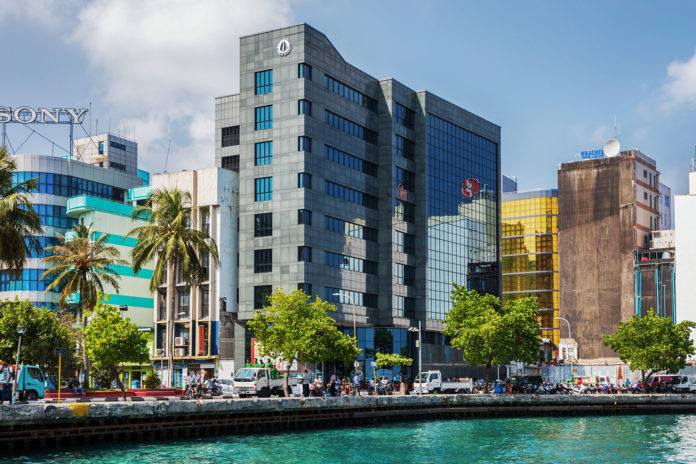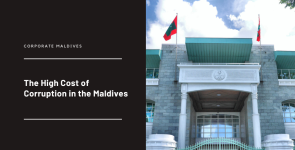
Report by: Shifneen Rasheed & Daha Shuaib
The year 2016 was a promising year for the financial sector of the Maldives. As the country strives to attain its developmental targets, a number of measures were taken to achieve greater financial inclusion in the country during 2016.
Up until now the financial sector of the Maldives comprised of banks, non-bank financial institutions (NBFIs), securities market intermediaries and the pension fund. The banking sector consisted of seven commercial banks, which include two locally incorporated banks, four branches of foreign banks and one subsidiary of a foreign bank. NBFIs include finance companies, insurance companies, money remittance companies and money changers. While all commercial banks and NBFIs are licensed and regulated by the MMA, the securities market intermediaries and the pension fund are licensed and regulated by the Capital Market Development Authority (CMDA).
On September 26, 2016, the country saw the expansion of the banking sector with the inauguration of the ‘Commercial Bank of Maldives’ (CBM) — increasing the total number of banks to eight. With a capital of MVR150 million, CBM was opened in collaboration with Sri Lankas’ ‘Commercial Bank of Ceylon’— owning 55% share and its Maldivian partner Tree Top Investments, which owns 45% share in the venture. The new bank aims to promote the young business minds of the country, providing opportunities for them to indulge in new ventures and to lay a way forward for small enterprises. CBM is also set to offer housing loans, private loans and business loans in the future. Tree Top Investments, meanwhile, is working with a Turkish company on a US$80.0 million hospital project. The 159- bed tertiary hospital is to be built in Hulhumalé.
Following the commencement of the new bank on 29 September 2016 the country witnessed another important event where the largest bank, Bank of Maldives (BML), introduced a special branch for Islamic Banking. Prior to the opening of the new branch, Islamic Banking services were provided only by Maldives Islamic Bank (MIB). Since the demand and support for Islamic Banking is very high in the archipelago, the introduction of Islamic banking branch has indeed increased the opportunities for many people to use Shari’ah-Compliant modes of banking. Named as the BML Islamic Headquarters, the sector envisages the provision of country-wide services and catering for public requirements. BML Islamic allows its customers to transfer their accounts at BML to Shari’ah-Compliant accounts easily. Under BML’s Islamic banking policy, all the branches of the bank already offer special Islamic personal and business accounts named “Wadi’ah” to its customers, along with “BML Islamic Visa Debit” cash cards. At present, the Maldives is among the top 15 developed nations in the Islamic finance industry, according to the ICD–Thomson Reuters Islamic Finance Development Indicator (IFDI) 2016 and Islamic Finance Development Report 2016.
For a healthy financial sector, well-functioning payment systems are vital for financial stability and economic prosperity. The Maldives Monetary Authority implemented the automated cheque clearing process in order to deliver a faster and secure payment system that will improve the efficiency of the payment process. Prior to the implementation of the automatic cheque clearing process, cheques generally cleared in three to four days. Furthermore, steps to increase the financial sector inclusion and development have been steered well with the opening of new branches in different atolls by several banks. The year 2016 has also seen a boost in private sector lending by the commercial banks. The total amount of loans and advances hover well above that of 2015, and are significantly higher in terms of year on year growth rate of lending. The sluggish private sector credit that stood at around 4% on average during 2015 increased to a massive 11% in 2016.
Another important development that took place during the second quarter of 2016 in the financial sector was Maldives Monetary Authority issuing a regulation on mobile payment services and issuing the first license to Ooredoo Maldives to conduct mobile payment services in the country. This is expected to alleviate the tremendous difficulties faced by the locals due to the absence of bank branches in some islands and it also paves way for a lesser cashbased financial sector. Many choose to think of Mobile Commerce as a form of retail outlet in the customer’s pocket. Rebranded as m-Faisaa, it offers an easy, safe and convenient method to manage money. It is a mobile wallet service allowing the customer to register for a ‘Mobile Wallet Account’ to deposit, withdraw, pay and send money in Maldives instantly through their phone. Currently only a few companies provide the facility, including State Electric Company Limited (STELCO), State Trading Organisation (STO), Raajje Online Limited (ROL), Medianet, Food Hub and Schwack cinema.
It is evident that the financial sector has indeed flourished. The sector has given extra care to stimulate the investment and financing options in order to provide a healthier, viable and a competitive business atmosphere. One such noteworthy development is the registration of the Maldives first investment fund by the CMDA under the name, Watercress Growth Fund Pvt Ltd. The purpose of establishing such a fund is to boost public confidence in similar funds and provide prospects to the public to participate in such investments and enjoy the benefits. The approach is intended to increase funding to develop the capital market industry and more importantly to bring in profit to the community. This will help facilitate growth and development of the economy. Another successful event this year, was the Maldives Investment Forum held in Delhi. Being the prime investment event of the government of the Maldives, the forum provides copious opportunities for business partnerships and exhibiting investmentready projects in Maldives. This year, the investment sectors include finance and banking, real estate, tourism, information and communication technology, and renewable energy.
Alongside the development of the banking sector, the NBFIs also expanded. Two new insurance companies – Solarelle Insurance Pvt Ltd and Dhivehi Insurance Company,were launched, leading to the growth of the insurance sector. While the stakeholders of both companies are 100% Maldivian, the Dhivehi Insurance Company is one stride ahead in this regard by also employing only Maldivians. The opening of both these insurance companies has broadened the employment opportunities especially for the locals and has started a variety of general insurance services. This has led to a widening of customer choices and a more competitive market, thriving to deliver quality services, with a consistent, fair and equitable approach. Currently some of the services provided by Solarelle Insurance include aviation insurance, property insurance, ship builders insurance etc. and also intend to target the tourism sector while the Dhivehi Insurance Company initially aims to target the business sector alongside other products as well.
Upholding confidence in the currency of a country is extremely essential for the smooth functioning of an economy. In this regard, 2016 was undoubtedly a historic year for the country. The Maldives Monetary Authority introduced the new bank note series ‘Randhihafaheh’ into circulation in January. For the first time in the history of Maldives, paper notes were replaced with a new substrate – polymer notes. The new notes were designed by a young and extremely talented local artist Mr. Abdulla Nashath. The new polymer series was set entirely apart from the previous ones in terms of its modern and innovative features. The new series also highlights substantial improvement in its security and durability in comparison to the paper note series. A notable feature includes the use of tactile dots for partially sighted people. This is an important milestone that has been achieved; being able to cater to the needs of all the classes of the society. Most importantly, the ‘Randhihafaheh’ series also introduced a new denomination to the note family – the 1000 rufiyaa note. Hardly used outside the banking system, the 1000 rufiyaa denomination is mainly targeted towards the facilitation of large cash transactions. Apart from being the most exclusive denomination, the 1000 rufiyaa note has also bagged 2nd place in “Bank Note of the Year” by the International Bank Note Society (IBNS).













